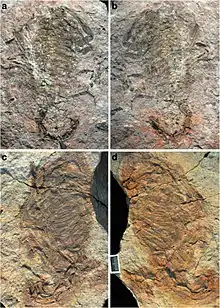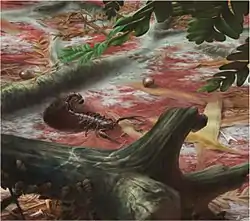| Opsieobuthus Temporal range: Late Carboniferous-Early Permian, | |
|---|---|
 | |
| Holotypes (A-B) and paratypes (C-D) of O. tungeri | |
| Scientific classification | |
| Domain: | Eukaryota |
| Kingdom: | Animalia |
| Phylum: | Arthropoda |
| Subphylum: | Chelicerata |
| Class: | Arachnida |
| Order: | Scorpiones |
| Family: | †Centromachidae |
| Genus: | †Opsieobuthus Kjellesvig-Waering, 1986 |
| Type species | |
| †Opsieobuthus pottsvillensis Kjellesvig-Waering, 1986[1] | |
| Species | |
| |
Opsieobuthus is an extinct genus of centromachid scorpion. The type species O. pottsvillensis was named from the late Carboniferous of Clay City, Indiana.[1] A second species ?O. tungeri was tentatively assigned to the genus from the Early Permian Chemnitz petrified forest in Germany.[2]

An artist's illustration of O. tungeri at the mouth of its burrow
References
- 1 2 Kjellesvig-Waering, E. N. (1986). "A restudy of the fossil Scorpionida of the world". Palaeontographica Americana. 55: 1–287.
- ↑ Dunlop, Jason A.; Legg, David A.; Selden, Paul A.; Fet, Victor; Schneider, Joerg W.; Rößler, Ronny (2016). "Permian scorpions from the Petrified Forest of Chemnitz, Germany". BMC Evolutionary Biology. 16 (1): 72. doi:10.1186/s12862-016-0634-z. PMC 4823912. PMID 27056633.
External links
 Media related to Opsieobuthus at Wikimedia Commons
Media related to Opsieobuthus at Wikimedia Commons
This article is issued from Wikipedia. The text is licensed under Creative Commons - Attribution - Sharealike. Additional terms may apply for the media files.